.svg)

You walk into a networking event, hand someone a paper card, and watch it disappear into a pile. Best NFC business cards change that by letting you tap to share contact details, links, social profiles, and payment options in a single instant. Want to make lasting professional connections with a sleek, savvy card that elevates your personal brand? This article compares top smart business cards, explains how contactless sharing works, and shows you how to set up your digital profile to leave a stronger impression.
Mobilo's digital business card helps you do precisely that, with NFC-enabled cards, mobile-friendly landing pages, and easy vCard and LinkedIn integration so you can tap to share and capture leads without fuss.
This is where Mobilo's digital business card fits in, by offering NFC-enabled cards, mobile-friendly landing pages, and CRM routing that compresses follow-up windows from days to hours.

NFC stands for Near Field Communication, and an NFC business card utilizes this short-range wireless technology to transfer data with a single tap, eliminating the need for typing or an app.
Think of the card as a physical trigger that opens a digital profile on a phone, where recipients can:
The card contains a tiny passive chip that wakes when a phone comes within a few centimeters, exchanges a small packet of data, and then hands it off to the phone’s browser or contacts app.
The mechanism is the same, reliable contactless protocol used for mobile payments and access control, so the interaction feels immediate and familiar, like a small, deliberate handshake through the air.
An NFC card can deliver a vCard that saves directly into contacts, a URL to a digital business card or portfolio, links to social profiles, or documents and product pages.
After working with event teams over a six-month trade show cycle, a pattern emerged: linking the card to a dynamic digital profile enables teams to update links and tracking in real-time, and this simple flexibility is what turns one-off encounters into measurable follow-ups.
Most people want fewer steps between meeting someone and following up, which is why NFC Business Card Survey reports that 85% of professionals believe that NFC business cards are more convenient than traditional paper cards, a finding that explains why adoption often follows ease of use rather than novelty.
There is also a pragmatic environmental argument, as the Environmental Impact Study finds that NFC business cards can reduce paper waste by up to 90%, providing a clear metric for teams tracking sustainability goals and CSR reports.
Most teams hand out paper cards because it is familiar and fast at the moment.
That approach works until scale arrives:
The hidden cost is not just the cost of printing, but also measurable time and missed opportunities.
Platforms like Mobilo turn the tap into a workflow:
It allows teams to follow up in hours, not days. This is not about novelty; it is about converting a physical moment into CRM-ready data with consistent reporting and team-level controls, so event programs scale without manual re-entry or fragmented spreadsheets.
There is a short learning curve; some attendees may need a QR fallback, and not every phone has NFC enabled by default. That upfront friction pays off. Expect fewer physical cards to manage, faster follow-up times, and cleaner lead data.
The simplest mental model: the card replaces repetitive manual entry with a single, trackable action that preserves context and intent.
That first tap feels small, but the downstream shift in how teams capture, score, and act on leads is where the real business case appears. But the real test is which specific cards deliver speed, reliability, and CRM-ready data at scale, and that’s where things get interesting.

Mobilo builds NFC-enabled cards, along with a team-focused platform that treats every tap as a sales signal, not a novelty.
The cards link to:
It allows teams to act within hours instead of days.
You design profiles in a web dashboard and pick card finishes; the platform supports live edits, so a single distributed card can point to updated content instantly.
Mobilo offers design assistance for teams, allowing you to preview pages before committing, which is particularly practical when brand approvals are involved.
Options include PVC, wood, and metal finishes; pricing is enterprise-friendly, with discounts available for volume. Build quality is solid and consistent, and the variety spans from conservative corporate looks to higher-impact premium metal cards.
Mobilo feels engineered for teams who track ROI from events, not just style.
This is a top pick if your priority is:
Budget for platform fees if you want full automation and team governance.
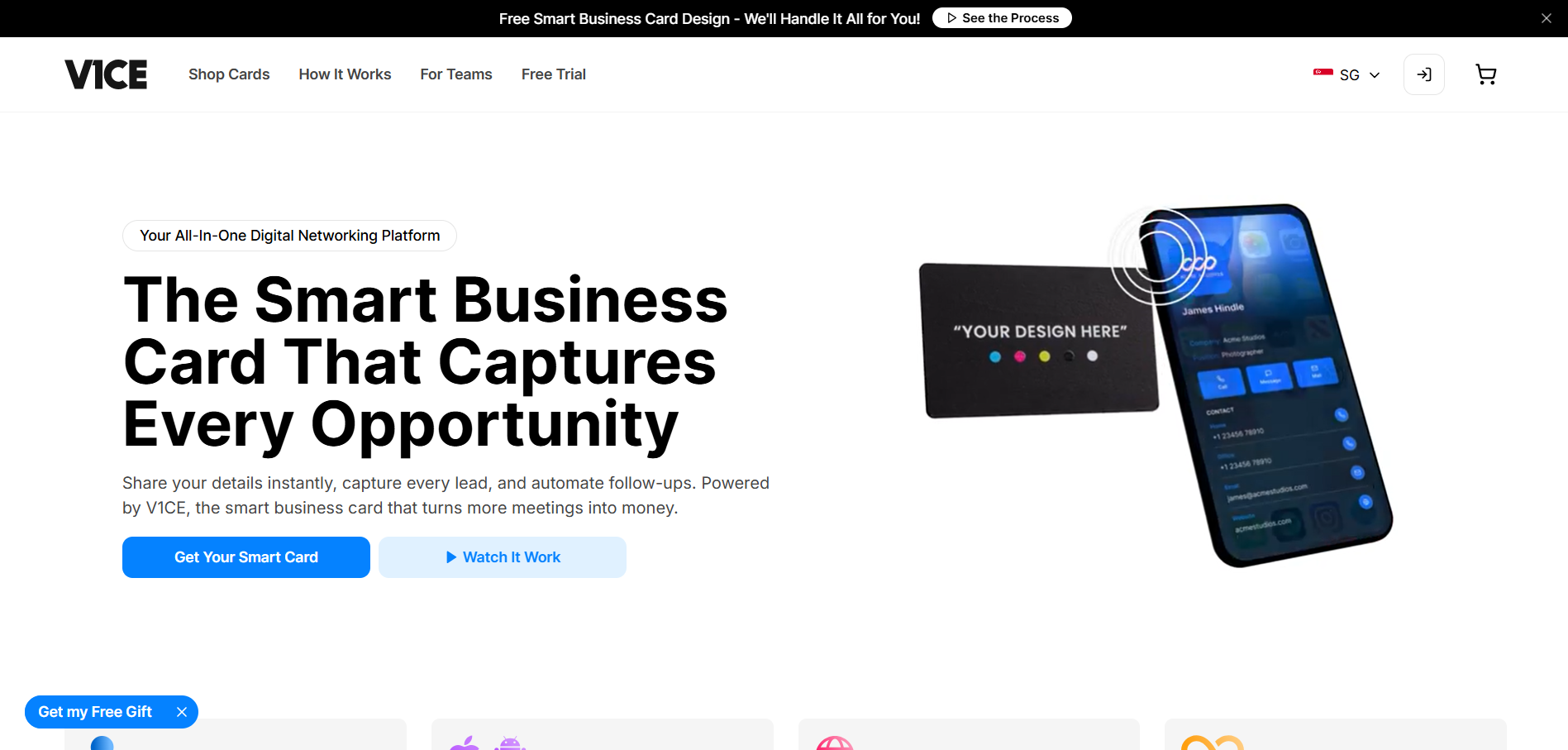
V1CE packages polished physical cards with an easy-to-use online editor and an assisted design path. The exchange is tap-or-scan with no recipient app required, and the company emphasizes durable, premium materials.
You can self-design or request V1CE’s design support; the process includes proofs and the ability to tweak before production, which lowers the risk of reprints for brand-sensitive users.
Product lines include:
Plastic is the most affordable. V1CE prioritizes quality over bargain pricing, so expect mid-to-upper price points, but with robust build and color options.
V1CE is designed for individuals who desire a premium tactile card and a low-friction design experience, particularly those who prefer a vendor-guided creative workflow.

Popl focuses on mainstream accessibility:
Through a friendly onboarding experience, it manufactures NFC cards in:
You design within an app-driven editor, and recipients generally need the Popl profile linked or the app for advanced features; simple sharing works without extra installs.
PVC, metal, and a 24k gold option are available; branded custom cards start affordably, with optional fees to remove Popl branding.
Popl blends style and accessibility. It is an excellent entry option for teams that want branded, shareable cards without a heavy enterprise footprint.
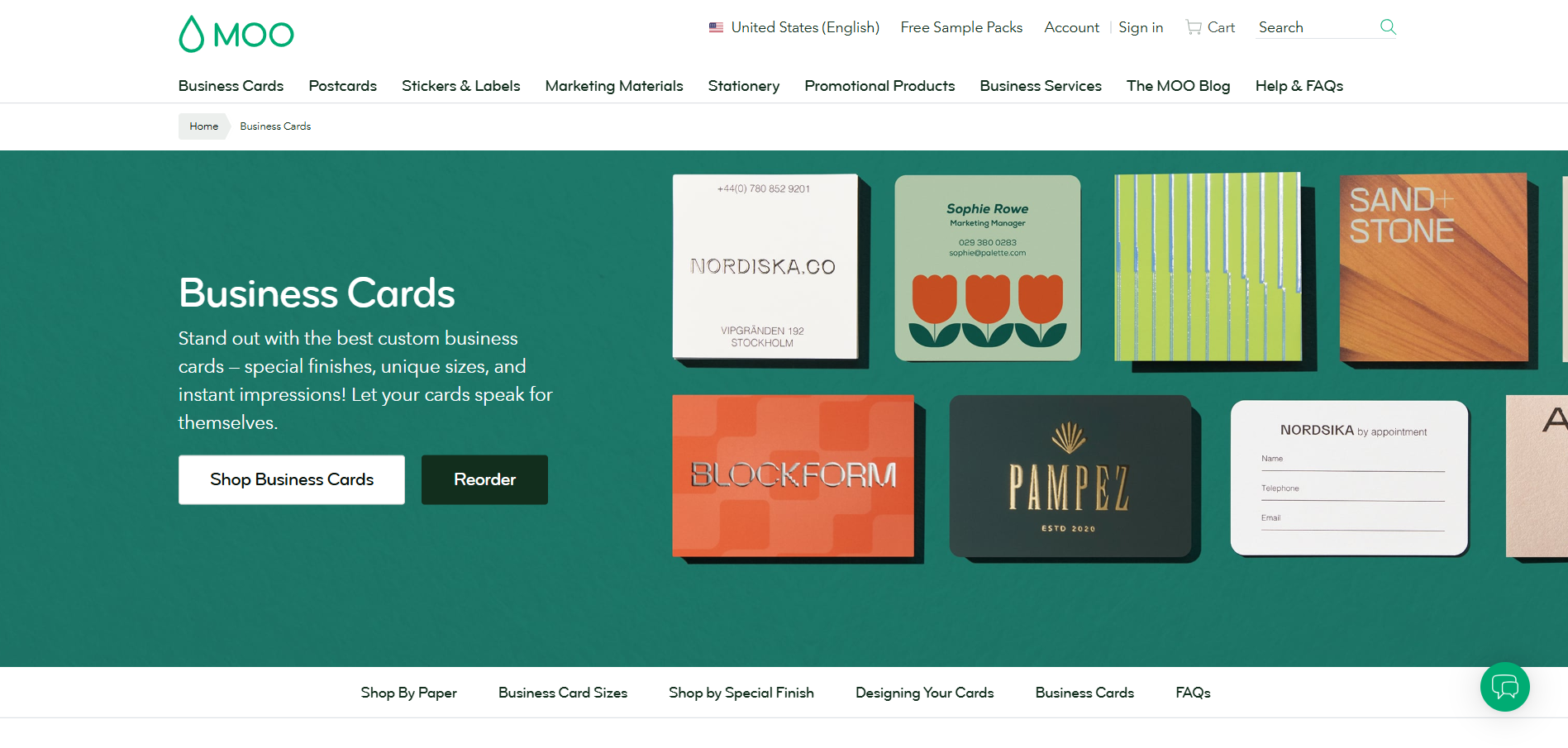
Moo Card elevates print quality and tactile design, combining thick, soft-touch stocks with NFC capability for individuals who desire a premium feel and technology.
The platform features beautiful templates designed for creatives and executives.
Moo’s online editor offers numerous templates and allows for uploads, with a preview step. The card links to a persistent digital profile that you can update without needing to reprint.
High-grade printed stocks with laminate and recycled-paper options. Pricing is premium due to the print process and the use of thicker card stocks.
Use Moo Card when the handshake matters: you want the physical card to feel like a brand statement while still offering NFC convenience.
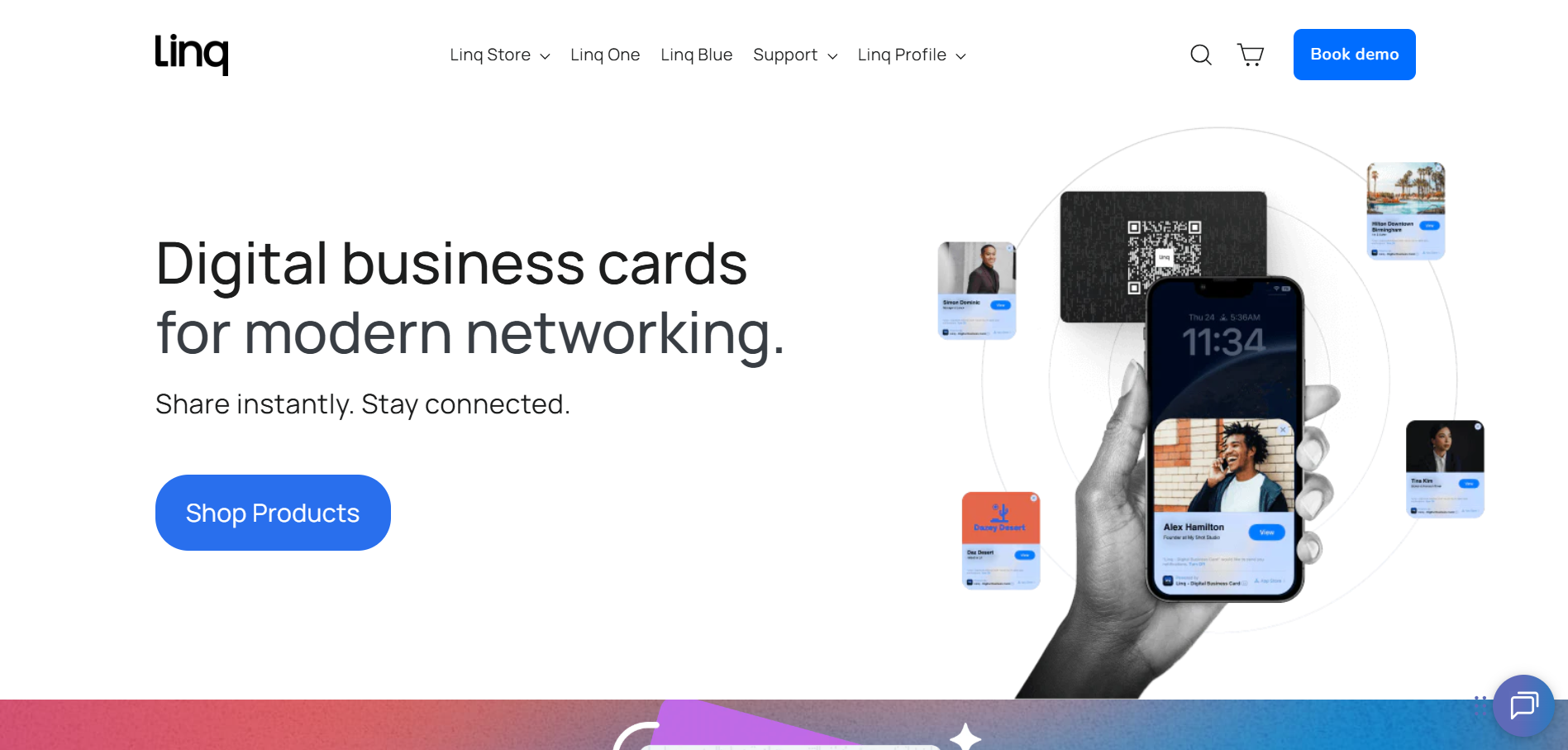
Linq offers polished cards and a focus on social and payments integration; it has a clean interface and multiple materials. Customization varies by material, with plastic receiving the deepest design control.
Linq provides full customization primarily on its plastic cards, while metal options are more constrained, which can disappoint teams with strong logo or finishing needs.
Polyvinyl plastic, bamboo, and premium stainless steel are offered; price tiers reflect material and customization level.
Linq works well for professionals who want a balance between design and functionality, provided your branding can fit the plastic card constraints.

mTap emphasizes a variety of form factors and practical sharing modes, including:
It’s built for teams that need flexible touchpoints rather than a single-card solution.
mTap offers custom business cards and white-glove services for teams that require hands-on setup, as well as offline QR options that work even when connectivity is spotty.
Pricing depends on the item type:
Stickers and fobs are inexpensive ways to add NFC to existing touchpoints.
mTap is a toolset rather than a single product, useful when you want NFC across many physical touchpoints.

Blinq focuses on quick, hygienic sharing, offering card options that range from bare-bones to fully customized. It tracks meeting context and offers integrations that help teams keep follow-ups organized.
Blinq provides tiered physical cards and a digital widget for smartphones; editing the linked profile is straightforward and quick for field updates.
Essential, Infinite, and Custom cards cover price tiers from economical to fully branded; the custom option unlocks more creative freedom.
Most teams still hand out paper or basic branded cards because it feels familiar and requires no new training. That works until event volume grows, and then data splinters across spreadsheets, follow-ups slip into long tails, and valuable context is lost, often without anyone noticing.
Platforms such as Mobilo change that equation by routing taps directly into:
Teams can compress follow-up windows from days to hours while maintaining a clear audit trail and ensuring team controls are in place.

L-Card combines a free digital card builder with an NFC card shop, offering a hybrid choice for users who want both DIY and ready-made hardware.
Its editor is feature-rich, and the hardware is available in:
The free L-Card app allows you to create a profile with various themes and export it to NFC hardware; orders for wood and metal products undergo a separate production preview.
PVC plastic, stainless steel, and Sapele wood are available; wood is the eco-focused premium option and often priced accordingly.
Metal and wood customizations may take longer to produce.
L-Card is a pragmatic choice when you want a powerful digital editor with the option to buy hardware later.
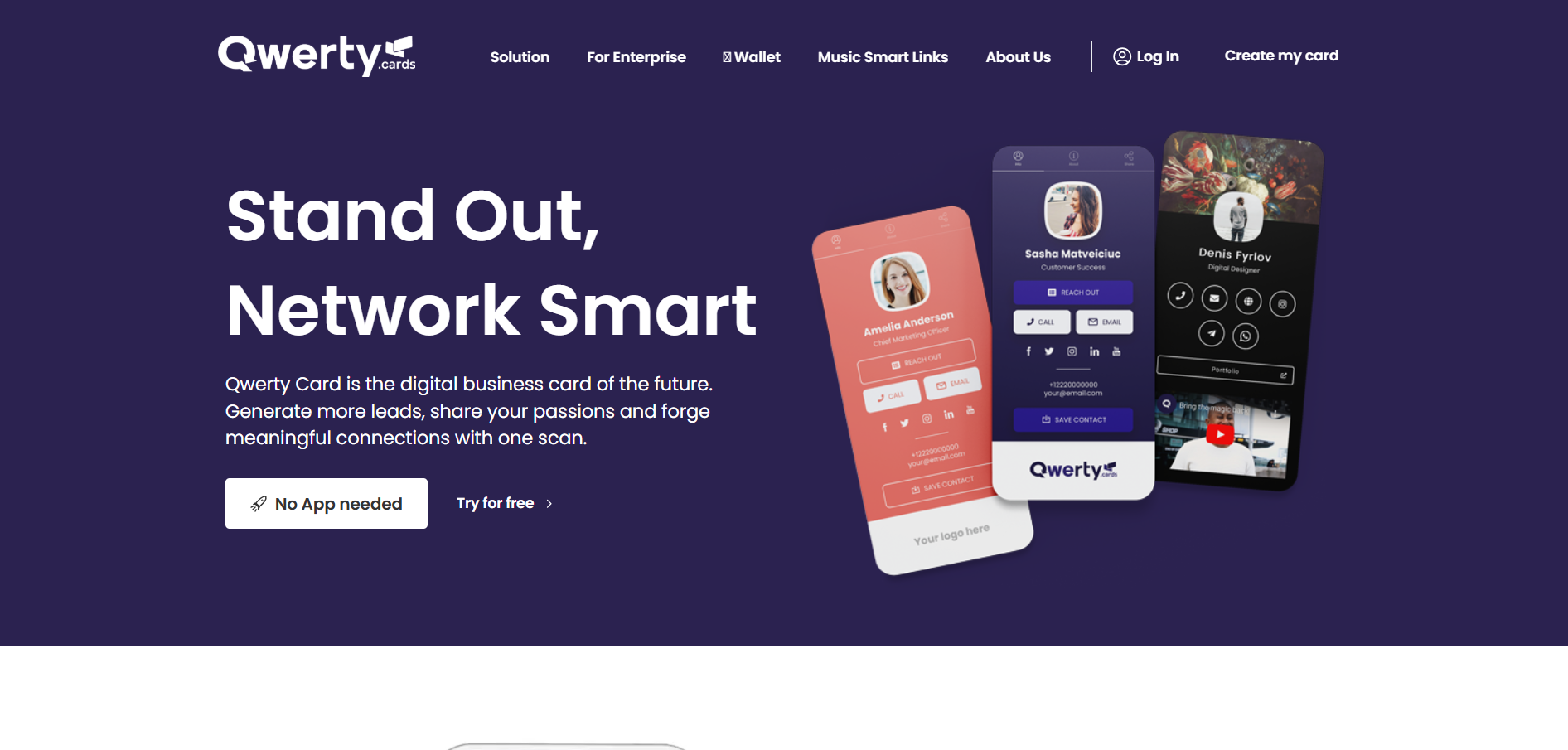
Qwerty Card aims at lead generation with profile switching and an admin dashboard for teams. It emphasizes data capture and straightforward exports to Excel or CRM.
The PRO and Lite product tiers offer different levels of design control, allowing you to manage multiple profiles from a single dashboard.
Qwerty Lite, PRO, and an entirely digital profile-only option enable teams to choose between hardware and a digital-only option, reducing costs.
The physicality and finish options are narrower than those of premium providers.
Choose Qwerty when your priority is structured lead capture and simple team management, with a focus on streamlined processes rather than premium materials.
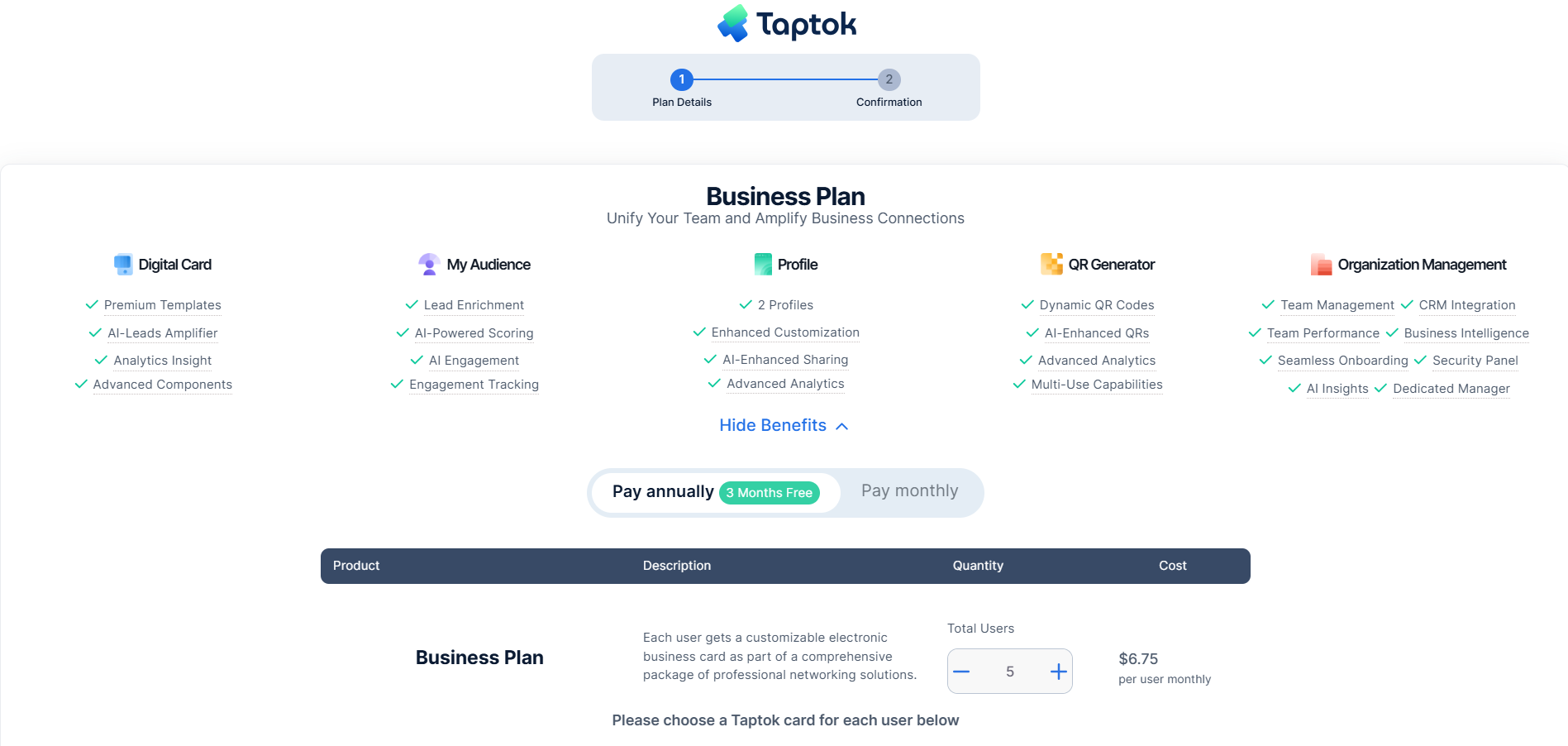
TapTok keeps things simple, no app required, and an NFC transfer that writes contact info directly to a recipient’s phone when supported. They sell cards and “dots,” which double as phone holders.
Basic profile editing is done online, but TapTok intentionally keeps the product simple, with fewer customization options than other providers.
Two main items:
Pricing is a one-time purchase with no subscription.
TapTok is an elegant, minimal option when you want a no-frills exchange and a simple platform.
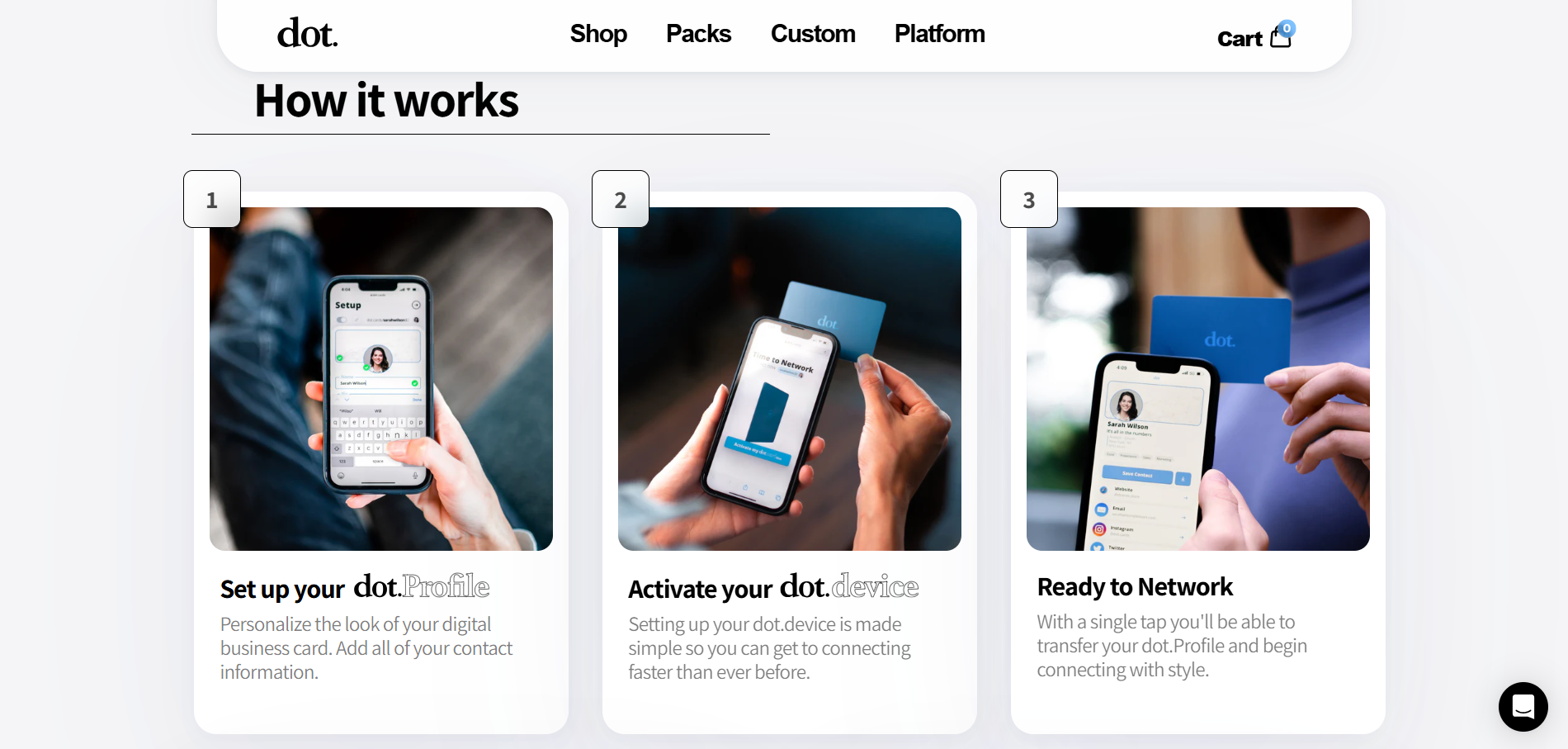
Dot sells straightforward, durable NFC cards with a focus on simplicity and consistent performance. Their price point and bundle options make them attractive for teams buying at scale.
Dot-branded cards are easy to customize, but full logo personalization requires a minimum run, which raises the entry cost for custom branding.
PVC and metal options are available, with Dot-branded units around $20 each and bulk discounts for teams.
Dot fits teams who want reliable basics and predictable costs, especially when high-volume procurement matters more than custom finishes.

TapSnap offers a low-friction PVC option with visual appeal, listed primarily on Amazon. It targets buyers who want a modern look without requiring enterprise features.
Limited color choices and the absence of a custom full-branding option make it less flexible for teams that require complete logo control.
PVC cards at a retail price point, limited color range, and no bulk discounts through the vendor.
TapSnap is ideal for individuals who want an attractive, retail-priced NFC card without the need for enterprise integrations.

TAPiTAG focuses on proximity marketing as much as business cards, with a catalog that spans:
It tilts toward organizations that want NFC for campaigns and lead collection.
Profile setup is guided via QR and online forms; TAPiTAG provides templates and production previews for custom orders.
Metal, wood, PVC cards, and phone tags cover everyday needs; pricing depends on the material and order size, but includes basic lead capture as a standard feature.
The market is expanding fast, so strategic choices matter: according to Market Research Future, the digital business card market is projected to grow from USD 181.46 billion in 2024 to USD 389.3 billion by 2032, with a compound annual growth rate (CAGR) of 10.01% from 2024 to 2032, which explains why vendors now compete on integrations and enterprise features.
At the same time, digital formats are proving sticky: digital business cards can boost user retention by up to 75% due to their ease of access and instant sharing capabilities, indicating that the right card, combined with workflow changes, can influence behavior over time.
This challenge is evident across conference booths and small sales teams: metal cards appear premium, but they often limit surface-level customization and, in live demos, sometimes require an extra tap on certain phones, creating awkward moments during quick exchanges.
When teams anticipate that, they choose plastic or keep a QR fallback, or they standardize on platform features that route any ambiguous interactions into automatic email capture, so no lead is lost.
If you need measurable, enterprise-grade lead capture and CRM-ready workflows at scale, prioritize platforms with:
If physical prestige is more critical than workflow, consider metal or premium finishes, but be aware of occasional tap friction and limited front/back printing options.
That solution seems useful until you realize one hidden tradeoff that most teams overlook.

You can build an NFC business card in two ways:
Follow a compact checklist, choose the material and tag type, design the landing page or vCard, write the NDEF record correctly, and then test it across devices before distribution.
For the lowest friction and built-in analytics, opt for a reputable provider and skip the wiring. If you need complete control over content, tracking, or per-card customization, consider purchasing blank NFC cards or tags and writing them yourself.
The tradeoff is time versus control: writing tags takes a few extra minutes per card but gives you rewritable links and full ownership of tracking parameters.
Plastic cards are suitable for bulk and predictable NFC performance. In contrast, metal requires an NFC-friendly design, such as a ferrite backing or tags specifically designed for metal to prevent signal loss.
Treat the antenna area like a no-print zone, keep logos and foil away from the chip location, and choose a card thickness that fits wallets and badge holders. Think of the antenna like a window; anything layered over it reduces signal strength, so plan your artwork and finish around the functional aperture.
Select NFC Forum Type 2 tags from the NTAG21x family when you require broad phone compatibility. The NTAG213 is a common choice, while the NTAG215 offers more user memory for storing larger payloads, and the NTAG216 provides even more.
Buy rewritable tags unless you are 100 percent certain the link will never change, because writing a short HTTPS redirect to a hosted profile keeps content editable and allows you to swap tracking without reprinting.
Select tags with proven adhesion and encapsulation to ensure the chip withstands pockets and badges.
Test on at least five distinct devices across iPhone and Android, including mid-range Android phones and flagship models.
Check these behaviors:
On iPhone, prefer a web link because iOS prioritizes URLs via NFC. On Android, you can test both vCard and URL flows, but verify the exact vCard format that the target phones accept. Run a 30-minute stress test where a colleague taps each card repeatedly to catch intermittent read issues before the first event.
Purchase tags from a reputable supplier with NFC Forum certification and specify durable NTAG21x chips instead of unbranded, generic tags. Use HTTPS links and short redirects to keep payloads small and secure. Avoid locking tags until you confirm everything works across devices and browsers.
Use a QR code fallback, stamped subtly on the card, in case a recipient’s NFC is not enabled. When designing team rollouts, assign one person to pre-write and log tag IDs so that you can later map physical cards to profile records.
When we conducted a preparation session over three trade shows, the pattern was consistent: the most awkward failures came from low-quality tags and cards whose artwork overlapped the antenna, resulting in slow reads under pressure. People often feel frustrated when a tap fails during a first impression, as that moment is brief and social.
The practical fix was repeatable and straightforward: write an HTTPS redirect rather than:
Most teams initially handle NFC adoption in a patchwork manner, as purchasing a few branded cards is a low-risk approach. That works until event volume grows and taps are supposed to become CRM signals, not one-off exchanges. As volume increases, inconsistent tag formats, missing redirect logs, and manual CSV uploads create bottlenecks that slow follow-ups from days to weeks.
Platforms like Mobilo centralize taps into native CRM integrations, automate routing to tools and lead scoring, and maintain a single, editable profile per card. This enables teams to transition from fragmented handoffs to CRM-ready leads in hours, rather than having to chase contact information later.
Be selective. Put one clear call to action up front, include essential contact and role info, and tuck extras behind tabs or links so the landing page remains fast and scannable.
Use brand colors and a headline, but prioritize readability and a single conversion point, such as ‘Save Contact’ or ‘Schedule Meeting’. Keep the physical card elegant, but ensure that every design choice serves the tap moment.
The market is changing quickly, and that matters for procurement and scale, as QR Code Chimp, “The global market for digital business cards is expected to reach $242.3 million by 2027.”
QR Code Chimp suggests that demand will continue to push vendors to add integrations and enterprise features, so choose hardware and workflows that can grow with you rather than forcing reprints.
One last practical justification before you print: physical cards still get tossed quickly, so make each printed item count, because QR Code Chimp reports that “Over 88% of business cards are thrown away within a week.” QR Code Chimp 2025 makes clear that a durable, trackable touchpoint captures far more life beyond the initial exchange.
Make it yours, but test like a rehearsal so the first tap feels effortless and the follow-up happens while the meeting is still fresh. That works for now, but one procurement choice can turn a neat pilot into a stalled program or a scaled win, and most teams miss which one.
We know swapping familiar paper habits for a new system feels risky, so book a Mobilo demo and test the tap-to-CRM workflow with a risk-free starter pack by claiming your first 25 Cards Free (Worth $950).
Teams clear the adoption hurdle with low-friction trials, which is why offers like 25 Cards Free help you prove quickly that a single tap keeps conversations warm and turns event contacts into CRM-ready leads.